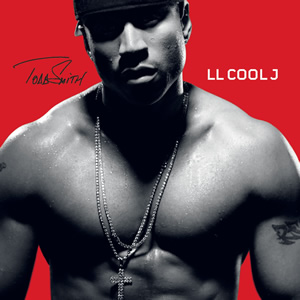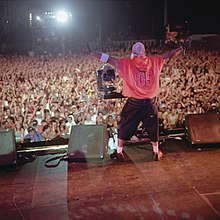The new school of hip hop was a movement in hip hop music, beginning in 1983–84 with the early records of Run–D.M.C., Whodini, and LL Cool J. Predominantly from Queens and Brooklyn, it was characterized by drum machine-led minimalism, often tinged with elements of rock; rapped taunts, boasts, and socio-political commentary; and aggressive, self-assertive delivery. In song and image, its artists projected a tough, cool, street b-boy attitude. These elements contrasted sharply with funk and disco, novelty hits, live bands, synthesizers, and party rhymes of artists prevalent in the early 1980s. Compared to their older hip hop counterparts, new school artists crafted more cohesive LPs and shorter songs more amenable to airplay. By 1986, their releases began to establish hip hop in the mainstream.

James Todd Smith, known professionally as LL Cool J, is an American rapper, songwriter, record producer, and actor. He is one of the earliest rappers to achieve commercial success, alongside fellow new school hip hop acts Beastie Boys and Run-DMC.

Bigger and Deffer is the second studio album by American rapper LL Cool J, released on May 29, 1987, by Def Jam Recordings and Columbia Records. With over two million copies sold in the United States, it stands as one of LL Cool J's biggest career records. Bigger and Deffer dominated the summer of 1987, spending 11 weeks at number one on the Billboard Top R&B/Hip-Hop Albums chart while also reaching number 3 on the Billboard 200. The album also became the fourth rap album to become a platinum album.

Frederick Jay Rubin is an American record executive and record producer. He is a co-founder of Def Jam Recordings, founder of American Recordings, and former co-president of Columbia Records.

Paid in Full is the debut studio album by American hip hop duo Eric B. & Rakim, released on July 7, 1987, by Island-subsidiary label 4th & B'way Records. The duo recorded the album at hip hop producer Marley Marl's home studio and Power Play Studios in New York City, following Rakim's response to Eric B.'s search for a rapper to complement his disc jockey work in 1985. The album peaked at number fifty-eight on the Billboard 200 chart, number eight on the R&B/Hip-Hop Albums chart, and produced five singles: "Eric B. Is President", "I Ain't No Joke", "I Know You Got Soul", "Move the Crowd", and "Paid in Full".

Def Jam Recordings is an American multinational record label owned by Universal Music Group. It is based in Manhattan, New York City, specializing predominantly in hip hop, contemporary R&B, soul and pop.

Lyor Cohen is an American music industry executive and entrepreneur. He has been actively involved in hip hop at various record labels for more than 30 years. He started by managing rappers for Rush Productions, then led Def Jam. After Def Jam, Cohen took on a leadership role at Warner Music Group. In September 2012, Cohen resigned from Warner and started his own independent label, 300 Entertainment. On September 28, 2016, Cohen was named YouTube's Global Head of Music.

Krush Groove is a 1985 American musical comedy-drama film distributed by Warner Bros. Pictures that was written by Ralph Farquhar and directed by Michael Schultz. This film is loosely based on the early days of Def Jam Recordings and up-and-coming record producer Russell Simmons, portrayed by Blair Underwood in his feature film debut. Simmons was the film's co-producer and story consultant; he also had a cameo in the film as a club owner named Crocket.

King of Rock is the second studio album by American hip hop group Run-D.M.C., released on January 21, 1985, by Profile Records. The album was produced by Russell Simmons and Larry Smith. King of Rock became the first rap album to be released on a CD, and was the third rap album to become a platinum album. The album saw the group adopting a more rock-influenced sound, with several tracks prominently featuring heavy guitar riffs. The song "Roots, Rap, Reggae" features Yellowman, and was one of the first hybrids of rap and dancehall.

Walking with a Panther is the third studio album by American hip hop recording artist LL Cool J, released June 9, 1989, on Def Jam Recordings.

Golden age hip hop refers to mainstream hip hop music created from the mid or mid-late 1980s to the early or early-mid 1990s, particularly by artists and musicians originating from the New York metropolitan area. A successor to the new-school hip hop movement, it is characterized by its diversity, quality, innovation and influence on overall hip hop after the genre's emergence and establishment in the old-school era, and is associated with the development and eventual mainstream success of hip hop. There were various types of subject matter, while the music was experimental and the sampling from old records was eclectic.

Todd Smith is the eleventh studio album by American rapper LL Cool J. It was released on April 11, 2006 by Def Jam Recordings. It includes collaborations with Jennifer Lopez, Pharrell, Juelz Santana, Teairra Mari, Jamie Foxx, Ginuwine, Mary J. Blige, 112, Mary Mary, Ryan Toby and Freeway. Producers on the project include Pharrell, Scott Storch, Bink!, Shea Taylor, Keezo Kane and Trackmasters.

"I Can't Live Without My Radio" is the lead single from LL Cool J's debut album, Radio. It was released in 1985 for Def Jam Recordings and was both written and produced by LL Cool J and Rick Rubin. It is a love song to the boombox. The song reached No. 15 on the Billboard R&B singles chart. "I Can't Live Without My Radio" was released with the follow-up single "I Can Give You More". It is the first Def Jam single distributed through Columbia Records.
Terrence "Terry" Ronnie Keaton known by the stage name T La Rock, is an American old-school emcee best known for his collaboration with Def Jam Recordings co-founder Rick Rubin and the 1984 single "It's Yours."
Chung King Studios was a recording studio that operated in New York City under that name from 1986 to 2015. It was founded by producer John King and engineer Steve Ett with financial backing from the Etches brothers, occupying three different locations during that era. Countless notable hip hop acts recorded music at Chung King Studios over the years, including Run-DMC, LL Cool J, Beastie Boys, Public Enemy, Busta Rhymes, Notorious B.I.G., Tupac Shakur, Lauryn Hill, Outkast, ODB, Method Man, Nas, Jay-Z, Hell Razah, Lil Wayne, and Kanye West. The studio became one of the most important recording spaces in the history of hip hop, pioneering commercial production of rap music. Beyond hip hop, notable groups like Aerosmith, Amy Winehouse, Beyoncé, Blondie, David Bowie Depeche Mode, Destiny's Child, Fergie, Lady Gaga, Maxwell, Moby and Phish also recorded there.

"Mama Said Knock You Out" is a song by American rapper and actor LL Cool J, released in February 1991 by Def Jam and Columbia as the fourth single from his fourth studio album of the same name (1990). The song famously begins with the line, "Don't call it a comeback/I been here for years." Before "Mama Said Knock You Out" was released, many people felt that LL Cool J's career was waning; his grandmother, who still believed in his talent, told him to "knock out" all his critics. The song takes various shots at Kool Moe Dee. It was produced by Marley Marl with help from DJ Bobcat along with LL.

"Rock the Bells" is the third single from LL Cool J's debut album, Radio. It was released in 1985 for Def Jam Recordings, was written by LL Cool J and produced by Rick Rubin. It was the follow-up to "I Can Give You More". "Rock the Bells" peaked at #17 on the Hot R&B/Hip-Hop Songs. Despite the song's title, no bells can be heard in the album recording. The original version of the song, riddled with bells of various types including a cowbell, is 7 minutes and 11 seconds long and was only released on 12 inch vinyl. It was based on the 1982 song "Breaking Bells" by Crash Crew.

"Sucker M.C.'s" is a song by American hip hop group Run-D.M.C. It was first released in 1983 as B-side to "It's Like That". The two-sided release marked the start of Run-D.M.C.'s career as their first single, and it is widely regarded as ushering in a new school of hip hop artists with a street image and an abrasive, minimalist sound that marked them out from their predecessors. Both tracks were collected on the trio's self-titled debut album in 1984. WBAU was the first station to play the two songs.
BobbyErvin, professionally known as Bobcat or DJ Bobcat, is an American Grammy Award winner and multi-platinum producer, songwriter, DJ, artist and music executive.

Run-DMC was an American hip hop group from Hollis, Queens New York, formed in 1983 by Joseph Simmons, Darryl McDaniels, and Jason Mizell. Run-DMC is regarded as one of the most influential acts in the history of hip hop culture and especially one of the most famous hip hop acts of the 1980s. Along with Beastie Boys, LL Cool J, DJ Jazzy Jeff & the Fresh Prince, and Public Enemy, the group pioneered new-school hip hop music and helped usher in the golden age of hip hop. The group was among the first to highlight the importance of the MC and DJ relationship.




















